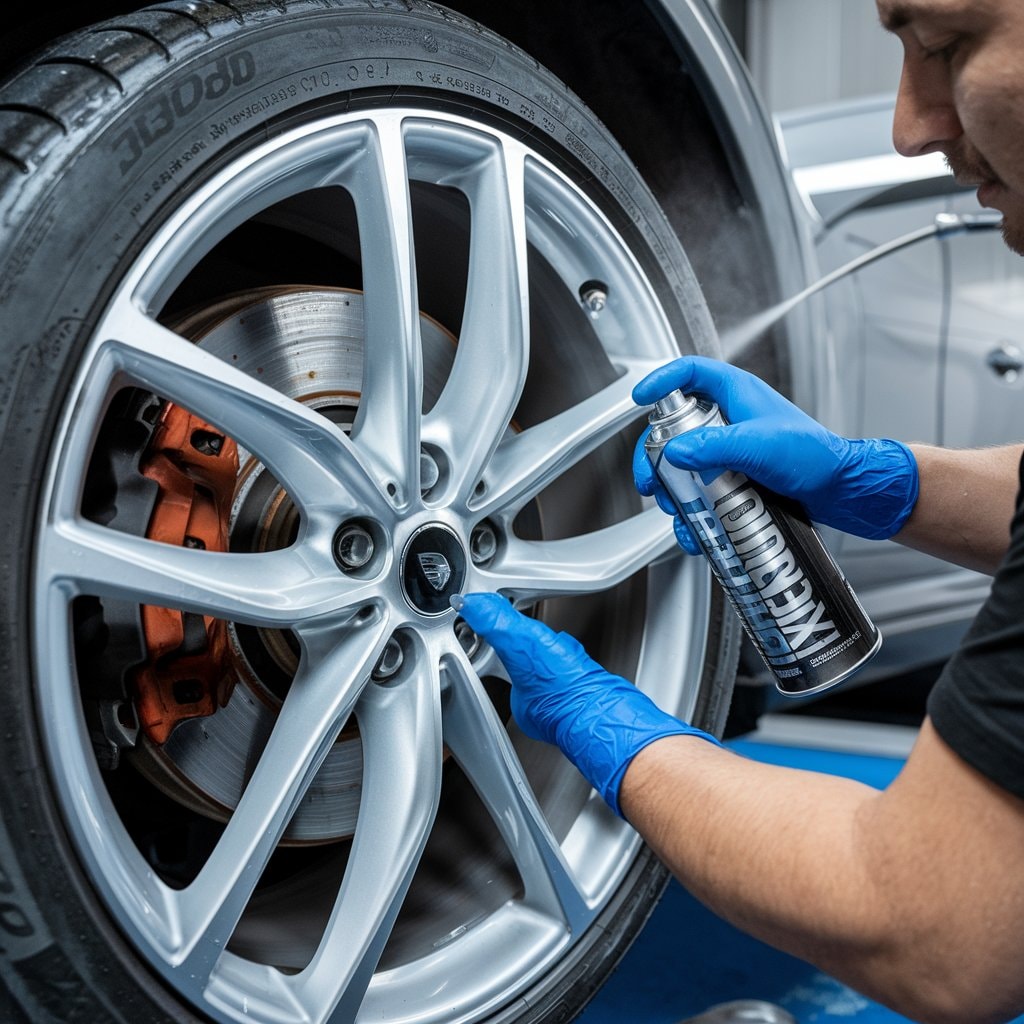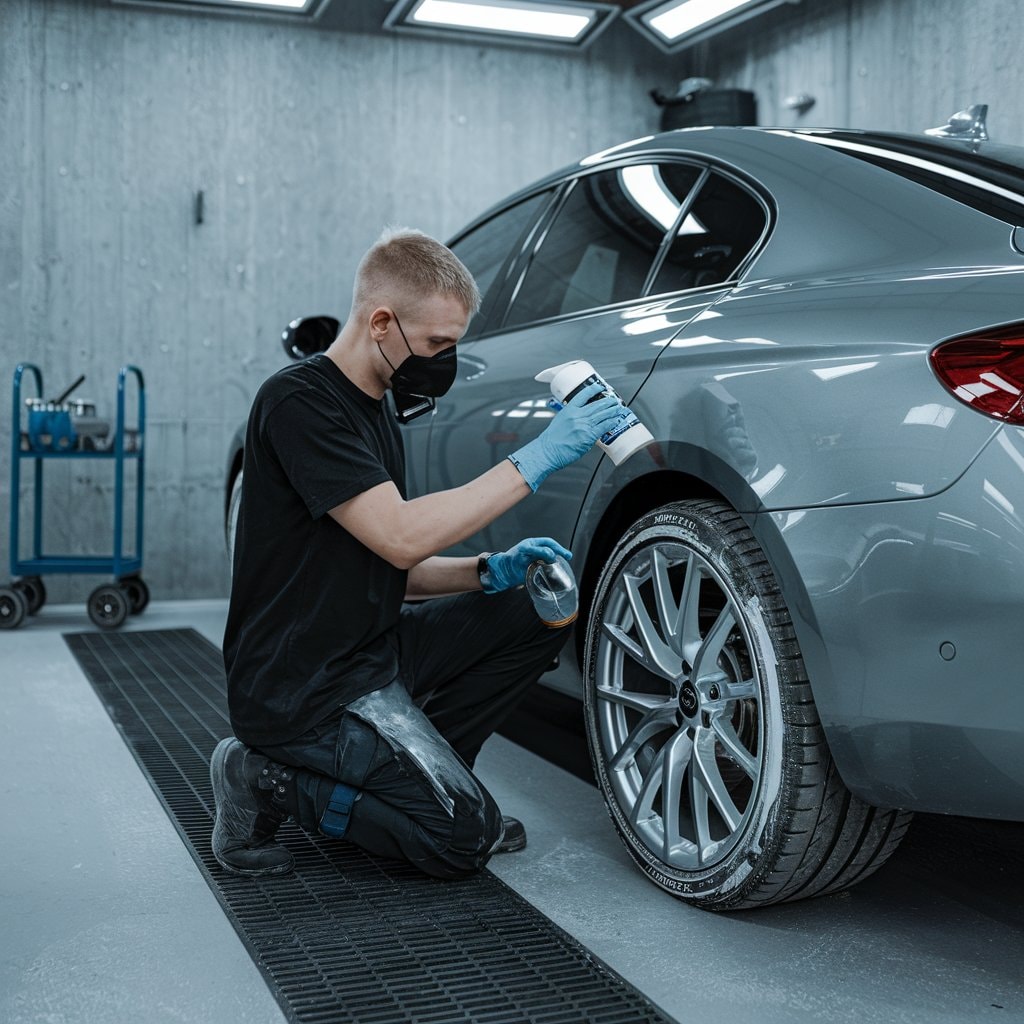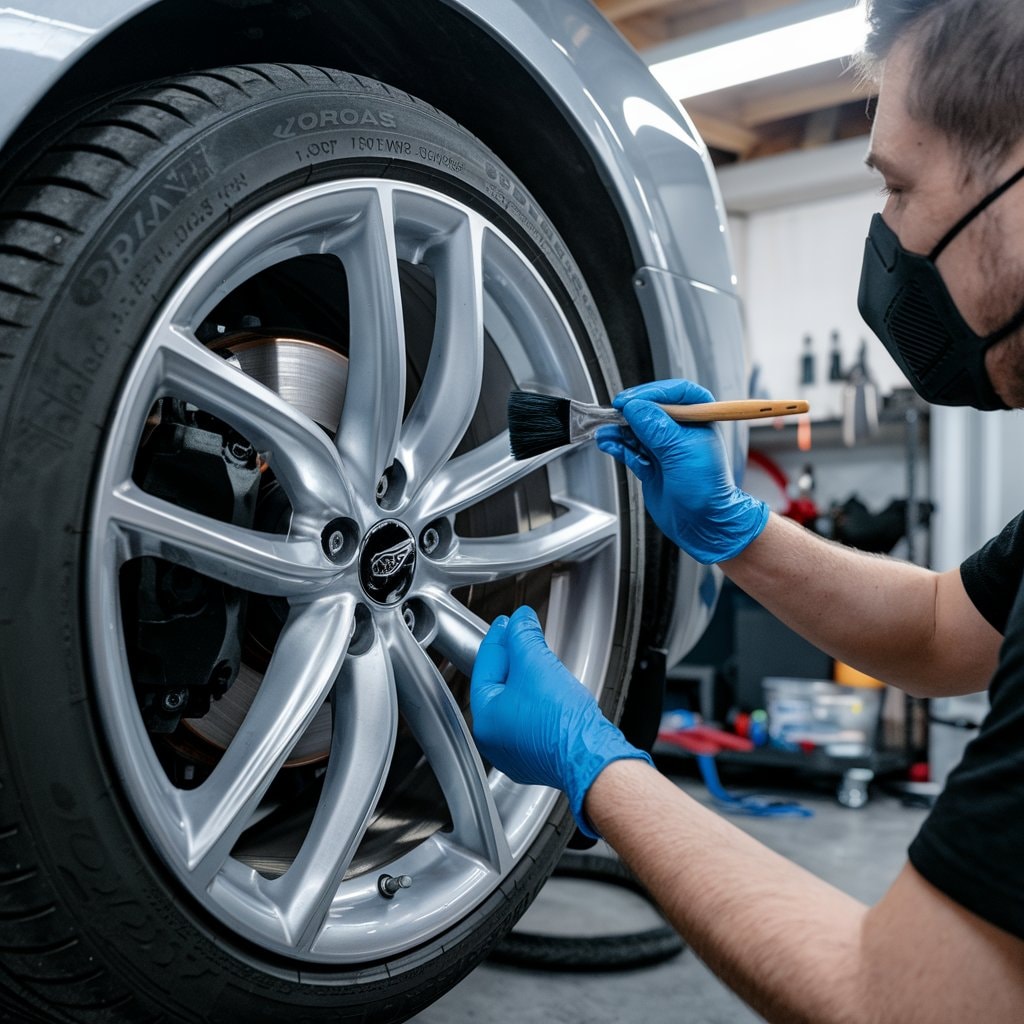To apply a long-lasting ceramic coating on wheels, start with a meticulous cleaning to remove all contaminants. Use a clay bar for fine particles, then apply the ceramic coating evenly, allowing each layer to cure completely before adding the next. Buff gently after curing for a glossy finish. Proper application guarantees superior durability and protection against elements and abrasions, enhancing aesthetics and performance. Further exploration reveals additional tips and techniques for maximal preservation of the coat.
What is Ceramic Coating on Wheels?
Ceramic coating on wheels is a protective finish that utilizes nanotechnology to shield surfaces from damage.
When applied to wheels, this coating enhances their aesthetic appeal and provides a barrier against brake dust and grime.
This treatment offers long-term benefits, including easier maintenance and improved durability of the wheel surfaces.
Understanding Ceramic Coating
Ceramic coating is a liquid polymer that bonds with the wheel’s surface, creating a durable protective layer. Nano ceramic coatings form a rigid shield against contaminants. Proper wheel cleaning before application ensures strong adhesion, enhancing durability and appearance.
The process includes pre-cleaning with wheel cleaners and microfiber towels and applying nano ceramic coatings to protect against dirt, brake dust, and grime. The coating then cures, sometimes with UV lamps, for added durability. An inspection with LED lights ensures even application. Maintenance involves mild soaps and soft cloths to preserve the protective layer.
Benefits of Applying Ceramic Coating to Wheels
Applying ceramic coating to wheels offers numerous benefits, enhancing aesthetics and functionality.
Ceramic coating on wheels acts as a protective layer that shields the wheels from various environmental hazards, providing best wheel protection. The hydrophobic properties of the coating also make the wheels easier to clean, as water and wheel cleaner glide off more smoothly.
Key advantages include:
- Additional Protection: Shields from UV rays and harsh chemicals.
- Enhanced Durability: Coated wheels are more resistant to scratches and wear.
- Improved Appearance: Maintains a cleaner, glossier look with less effort.
- Ease of Cleaning: Minimizes brake dust and dirt adherence, simplifying wheel care.
These features make ceramic coatings highly valuable for maintaining vehicle aesthetics and functionality.
How Ceramic Coating Protects Wheels from Brake Dust and Grime
Understanding the function of ceramic coatings reveals how they offer superior protection for wheels against brake dust and grime.
The ceramic coating acts as a robust barrier on wheels, repelling brake dust particles, and grime that typically adhere to the wheel’s surface. This protective layer not only makes cleaning the wheels easier but also prevents the corrosive effects of these contaminants.
When applying the coating, a thorough application using a microfiber towel guarantees even coverage. Once coated, the wheels require a simple wipe down to remove any dirt, significantly minimizing the need for harsh chemicals that could harm the wheel finish.
This method of protection guarantees that wheels maintain their aesthetic appeal and integrity longer than their untreated counterparts.
How do you prepare wheels for the ceramic coating application?
Preparing wheels for ceramic coating begins with thoroughly cleaning to eliminate dirt and grime, ensuring the surface is pristine.
Paint correction is vital as it rectifies imperfections that could hinder the coating’s performance.
Selecting an appropriate wheel cleaner and iron remover is essential to effectively preparing the wheels for the coating process.

Cleaning the Wheels: Removing Dirt and Grime
Before applying a ceramic coating, it is essential to thoroughly clean the wheels to confirm the removal of all dirt, grime, and debris. Proper preparation of the wheel’s surface is critical to guarantee the ceramic coating adheres well and lasts longer.
- Wash the Wheels: Start by getting the wheels wet and apply car shampoo using a clean microfiber towel to remove the initial layers of dirt.
- Apply Iron Remover: Spray iron remover liberally on the wheel’s surface to target and dissolve brake dust and other metallic contaminants.
- Clay Bar Treatment: Glide a clay bar over the surface to pick up leftover contaminants and smoothen the surface.
- Final Rinse and Dry: Rinse the thoroughly clean the wheels and dry them using a fresh microfiber towel, confirming no traces of water or cleaning products remain.
Importance of Paint Correction Before Coating
After the wheels are cleaned and dried, paint correction is the next step in preparing them for ceramic coating. This process involves using abrasive tools to remove any remaining contaminants from the car’s wheels, guaranteeing a smooth surface.
Paint correction is vital as it prevents the ceramic coating from locking in imperfections, which can affect the appearance and efficacy of the ceramic coating products. Once the surface is meticulously corrected, excess coating and residues should be removed with isopropyl alcohol.
This step is essential for promoting better adhesion of the ceramic coating to the wheels. Proper buffing is necessary to guarantee an even application, setting the stage for an effective curing process that solidifies the ceramic layer and offers long-lasting protection.
Choosing the Right Wheel Cleaner and Iron Remover
Selecting an appropriate wheel cleaner and iron remover is vital to guarantee ideal adherence to the ceramic coating. These products ensure that the wheels and calipers remain clean and decontaminated, essential before applying a ceramic coating.
Here are the steps to prepare the wheels:
- Choose a Wheel Cleaner: Opt for a pH-neutral cleaner that effectively removes dirt and grime while protecting the wheel surface.
- Apply Iron Remover: This helps eliminate embedded brake dust and iron particles, which are vital for keeping the entire wheel clean.
- Clean Lug Nuts and Tight Spaces: Ensure these often overlooked areas are free from road salts and debris.
- Dry Thoroughly: The surface must be arid to integrate the coating properly before applying ceramic coatings.
How to Apply Ceramic Coating Wheels?
Applying ceramic coating to wheels involves a step-by-step process that guarantees maximum adhesion and durability.
Essential tools must be gathered beforehand, including applicators, microfiber towels, and cleaning solutions tailored for this task.
For those aiming for an exceptionally glossy finish, specific techniques and tips can significantly enhance the aesthetic outcome of the coating.
Step-by-Step Application Process
Start the application process by thoroughly cleaning the wheels to remove any dirt, brake dust, or impurities that may hinder the bonding of the ceramic coating.
- Start Applying: Focus on one wheel at a time to maintain a clean and organized process. Apply the first layer of ceramic coating evenly across the surface.
- Let the Ceramic Coating Dry: Let the first coat fully dry before applying the second layer. This guarantees ideal bonding and durability.
- Add a Second Coat: Apply a second layer to enhance protection and gloss. This step reinforces the coating’s longevity.
- Gently Buff: After allowing the ceramic coating to cure, gently buff the surface to reveal a high-gloss finish. This not only enhances the look but also guarantees an even coat.
Tools Required for Applying Ceramic Coating
Several essential tools are necessary for effectively applying ceramic coating on wheels.
First, an applicator pad is vital; it allows for even coating distribution. Begin by placing a small amount of the ceramic product on the pad, typically just a few drops, to avoid excess. This process should ideally be performed out of direct sunlight to maintain the consistency of the coating.
Following the specific instructions for the coating product, use the pad to apply a thin, even layer across the wheel surface, ensuring that every area is covered to maximize shine.
Finally, a microfiber towel is needed to buff the wheel gently after application, removing any residual coating and enhancing the final appearance.
Tips for Achieving a Glossy Finish
After equipping yourself with the right tools and applying the ceramic coating, achieving a glossy finish on your wheels is the next step to guarantee they look great and are protected.
Here are key tips to enhance that shiny appearance:
- Select the Right Type of Coating: Opt for a high-quality ceramic coating designed for a glossy finish and black wheels.
- Thorough Application: Verify the coating is evenly applied to prevent patchiness and maximize the reflective qualities.
- Regular Maintenance: Keep wheels clean to maintain a shiny appearance and protect your wheels from harmful elements.
- Buffing: After application, gently buff the wheels to enhance the glossy finish, making your wheels look as good as possible.
This method is an easy way to protect your wheels and keep them looking good.
How Long Does Ceramic Coating Last on Wheels?
The longevity of ceramic coating on wheels can vary based on several factors, such as application quality and the level of wear and tear. The wheels endure.
Regular maintenance can significantly extend the life of the coating, ensuring continued protection against environmental elements.
It is also essential for vehicle owners to recognize the signs that indicate when it is necessary to reapply the ceramic coating to maintain ideal wheel performance and appearance.
Factors Affecting Durability of Ceramic Coating
Elements like driving habits, environmental conditions, and maintenance routines greatly influence the longevity of ceramic wheel coatings.
The durability of this protective layer can vary considerably depending on several specific factors:
- Exposure to Extreme Temperatures and UV Rays: High temperatures and ultraviolet light can degrade the coating more quickly, reducing its effectiveness.
- Frequency and Type of Driving: Regular exposure to harsh roads or chemicals like road salts can accelerate wear.
- Presence of Dust and Chemical Contaminants: Accumulated dust and reactive chemicals can erode the ceramic layer.
- Application Quality and Product Type: The initial application quality and the specific properties of the synthetic polymers used to impact how long the protection lasts.
Properly applied, ceramic coatings can considerably enhance a car’s paint, with protection lasting longer when waxes and other protectants are used periodically.
Maintenance Tips to Prolong Coating Life
Understanding that the longevity of ceramic coatings on wheels can be affected by numerous elements, it becomes equally important to contemplate how proper maintenance can extend their lifespan.
Regular cleaning with a few drops of a pH-neutral shampoo can provide additional protection, making it easier to maintain the coating’s integrity.
Focusing on one wheel at a time guarantees thorough attention to detail, which is critical for ideal results.
Consulting a professional detailer, recognized as an industry leader, can offer peace of mind, confirming that the techniques used are suitable for both the car’s paint and the wheels.
This specialized care helps prevent premature wear and tear, thereby enhancing the durability and aesthetics of the vehicle’s wheels.
Signs It’s Time to Reapply Ceramic Coating on Your Wheels
How can one discern when it’s time to reapply ceramic coating on wheels. For car owners seeking a long-lasting finish, recognizing the signs of deterioration is essential.
Here are key indicators:
- Reduced Gloss: If the wheels lose their high gloss, it suggests the ceramic coating is wearing off.
- Water Behavior: A decline in hydrophobic properties, where water no longer beads effectively, indicates a need for reapplication.
- Visual Damage: Any visible scratches or marks on the paint beneath the coating can signal protective failure.
- Dirt Retention: Increased difficulty cleaning wheels or noticeable dirt adherence could denote inadequate coating performance.
Car owners should guarantee timely reapplication to maintain peak protection and aesthetics of their vehicle’s wheels.

Is DIY Ceramic Coating Application Recommended?
When considering whether to apply ceramic coating to wheels by oneself, weighing the pros and cons of DIY versus professional application is essential.
Key factors include the potential for common mistakes that can arise from an inexperienced hand and the essential steps to attain a perfect finish.
Understanding these elements helps one decide if a DIY approach is suitable or if professional services provide a more reliable outcome.
Advantages and Disadvantages of DIY vs. Professional Application
Deciding between a DIY and professional application of ceramic coating on wheels often involves weighing the benefits and drawbacks of each approach. Here are key considerations:
- Cost Effectiveness: DIY ceramic coating can be less expensive. You avoid labor costs but may need to invest in high-quality products.
- Skill Level: Professional application guarantees expertise and experience, reducing the risk of a subpar finish. DIY demands a comprehensive knowledge of the process.
- Time Commitment: DIY application requires time and patience, especially for beginners. Professionals can complete the job more efficiently.
- Quality and Longevity: Professionals assure a high-quality, durable, aesthetically pleasing finish, potentially lasting longer than DIY applications, which vary based on the user’s skill and the products used.
Top Mistakes to Avoid When Applying Ceramic Coating
While evaluating DIY versus professional application of ceramic coating on wheels helps make an informed choice, it is just as important to identify and avoid common mistakes if opting for a DIY approach. Many enthusiasts believe it’s as easy as applying window film, but this misconception can lead to unsatisfactory results. Proper preparation and application are critical to protect the car’s paint and achieve the desired longevity and aesthetic.
Proper application of ceramic coating on wheels requires careful attention to each step. Inadequate cleaning can trap dirt beneath the coating, reducing its durability and effectiveness. Rushing the process leads to uneven application, which diminishes protection against contaminants. Ignoring curing time can cause the coating to fail within hours, preventing it from forming a strong, long-lasting bond with the wheel surface. To ensure maximum protection and longevity, each step must be followed diligently, from thorough cleaning to proper curing.
To avoid these mistakes, one must be thorough and patient, especially if one wants to guarantee a professional-quality finish.
How to Ensure a Flawless Ceramic Coating Application on Wheels
To guarantee a flawless ceramic coating application on wheels, meticulous preparation, and precise execution are paramount.
Whether to undertake this process as a DIY project depends on one’s skill level and familiarity with the required techniques.
For those considering a DIY approach, here are essential steps to follow:
- Thorough Cleaning: Remove all dirt, grime, and residues from the wheel surfaces.
- Surface Decontamination: Use a clay bar to eliminate any embedded contaminants.
- Drying and Inspection: Confirm the wheels are completely dry and check for any missed impurities.
- Application Precision: Apply the coating evenly using appropriate tools and techniques, following the product’s instructions.
These steps can lead to professional-level results, even for DIY enthusiasts.

Conclusion
In summary, the ceramic coating offers a durable layer of protection for wheels, enhancing aesthetics and longevity. Proper preparation involves thorough cleaning and possibly decontaminating the wheel surfaces. While DIY application is feasible, professional installation is recommended for best results. With correct application and maintenance, the ceramic coating can significantly extend the life and appearance of wheels, making it a worthwhile investment for vehicle owners seeking to maintain their vehicle’s value and appeal.






